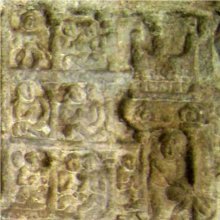Doorkeeper, Door-keeper: 2 definitions
Introduction:
Doorkeeper means something in Hinduism, Sanskrit. If you want to know the exact meaning, history, etymology or English translation of this term then check out the descriptions on this page. Add your comment or reference to a book if you want to contribute to this summary article.
Images (photo gallery)
In Hinduism
Vastushastra (architecture)
Source: Shodhganga: Elements of Art and Architecture in the Trtiyakhanda of the Visnudharmottarapurana (vastu)Two images of Doorkeepers should be placed in a temple, according to literature such as the Bṛhatsaṃhitā and the Viṣṇudharmottarapurāṇa, an ancient Sanskrit text which (being encyclopedic in nature) deals with a variety of cultural topics such as arts, architecture, music, grammar and astronomy.—According to the Bṛhatsaṃhitā, two images of doorkeepers should be placed in a temple and the Viṣṇudharmottarapurāṇa says that both sides of the steps of a temple should be decorated with the statue of two lions. The Sun temple of Konark is a great example of this Architecture as two statues of lions can be noticed in both the sides of the staircase.

Vastushastra (वास्तुशास्त्र, vāstuśāstra) refers to the ancient Indian science (shastra) of architecture (vastu), dealing with topics such architecture, sculpture, town-building, fort building and various other constructions. Vastu also deals with the philosophy of the architectural relation with the cosmic universe.
Shilpashastra (iconography)
Source: Shodhganga: Elements of Art and Architecture in the Trtiyakhanda of the Visnudharmottarapurana (shilpa)The Door-keeper refers to a certain class of personalities which follows specific guidelines in the tradition of ancient Indian Painting (citra), according to the Viṣṇudharmottarapurāṇa, an ancient Sanskrit text which (being encyclopedic in nature) deals with a variety of cultural topics such as arts, architecture, music, grammar and astronomy.—In the Viṣṇudharmottarapurāṇa, the rules of Painting of different classes [e.g., door-keepers] have been elaborately discussed. Like cloths, accessories of different character also vary in their pictures. The picture of a pratīhāra i.e., door keeper should be adorned with a staff in his hand and a sword hanging along his side. In Bānabhatta’s Kādambarī, a reference of holding golden stick by door keeper is found which corroborates with the idea of the picture of a door keeper as narrated in the Viṣṇudharmottarapurāṇa.

Shilpashastra (शिल्पशास्त्र, śilpaśāstra) represents the ancient Indian science (shastra) of creative arts (shilpa) such as sculpture, iconography and painting. Closely related to Vastushastra (architecture), they often share the same literature.
See also (Relevant definitions)
Partial matches: Door, Te, Doorkeeper.
Query error!
Full-text (+271): Pratihara, Dvarapala, Vetradhara, Dauvarika, Vetrin, Dvarapalaka, Mahapratihara, Garvata, Utsaraka, Dvarika, Dvarastha, Vetala, Dvahstha, Dandahasta, Rakshapekshaka, Udasthita, Dvahsthita, Darshaka, Dvarapa, Sambadhana.
Relevant text
Search found 125 books and stories containing Doorkeeper, Door-keeper, Door-keepers, Doorkeepers, The door-keeper, The doorkeepers; (plurals include: Doorkeepers, keepers, keeperses, Doorkeeperses, The doorkeeperses). You can also click to the full overview containing English textual excerpts. Below are direct links for the most relevant articles:
Trishashti Shalaka Purusha Caritra (by Helen M. Johnson)
Part 6: Story of the faithful Brāhman < [Chapter I - Brahmadattacaritra]
Part 16: Ṛṣabha’s nirvāṇa < [Chapter VI]
Part 3: The Brāhman and Sagara < [Chapter VI - Emancipation of Ajita Svāmin and Sagara]
Agni Purana (by N. Gangadharan)
Chapter 220 - Accomplishment of assistance to the king (sahāya-sampatti)
Chapter 235 - The daily duties of a king
Chapter 218 - Mode of performing the coronation of a king (rājābhiṣeka)
Padma Purana (by N.A. Deshpande)
Chapter 58 - Lakṣmaṇa Leaves Sītā in the Forest < [Section 5 - Pātāla-Khaṇḍa (Section on the Nether World)]
Chapter 5 - War Between Gods and Demons < [Section 6 - Uttara-Khaṇḍa (Concluding Section)]
Chapter 70 - A Description of Śrīkṛṣṇa < [Section 5 - Pātāla-Khaṇḍa (Section on the Nether World)]
Prem Sagar (English translation) (by W. Hollings)
Vasudevahindi (cultural history) (by A. P. Jamkhedkar)
7. The inmates of a Palace (in ancient India) < [Chapter 2 - Political conditions]
20. The Royal Courtiers < [Chapter 2 - Political conditions]
6. Grants, wages and earnings (in ancient India) < [Chapter 4 - Economic Conditions]
Jivanandana of Anandaraya Makhin (Study) (by G. D. Jayalakshmi)
Analysis of Galagaṇḍa < [Chapter 6 - Dramatic aspects of the Jīvanandana Nāṭaka]
Analysis of Prāṇa (Pratīhārī / Dauvārika) < [Chapter 6 - Dramatic aspects of the Jīvanandana Nāṭaka]
Act IV (Summary) < [Chapter 3 - Summary of the Play Jīvānandana Nāṭaka]
